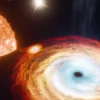Starting on August 19, the Valley will experience a rare celestial event with four consecutive supermoons appearing over the next four months. The first, called the “Sturgeon Moon,” will rise on August 19. The name stems from Native American traditions, symbolizing the time when sturgeon fish were most commonly caught, an important marker in their seasonal calendar. Each of these supermoons will offer a striking and memorable display in the night sky.
The four supermoons will occur on specific dates, each at varying distances from Earth. The Sturgeon Moon on August 19 will be 224,917 miles away, while subsequent supermoons on September 18, October 17, and November 15 will range from 222,055 to 224,853 miles. These varying distances explain why the moons will appear particularly bright, making the phenomenon stand out for skywatchers.

The best time to view the Sturgeon Moon is between the night of August 19 and the early morning of August 20. On the evening of August 19, the moon will be most visible in the eastern sky, reaching its peak brightness around midnight. It will then move towards the western sky, offering a prime viewing window just before sunrise on August 20. The positioning and brightness of the supermoon make it a special viewing opportunity.
Supermoons occur when the moon is at its closest point to Earth, known as perigee, coinciding with a full moon phase. This combination creates a visually striking effect due to the moon’s increased brightness, though its size may not seem noticeably larger. Supermoons also influence tidal patterns, often causing stronger tidal effects due to the closer proximity of the moon.
Unfortunately, weather conditions might make viewing the Sturgeon Moon difficult in some areas, as cloud cover and storms are forecast for the night of August 19. However, there is still hope for clear skies later in the week, and checking updated weather forecasts will help determine the best chances for observing this remarkable celestial event.

